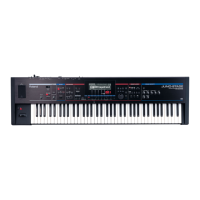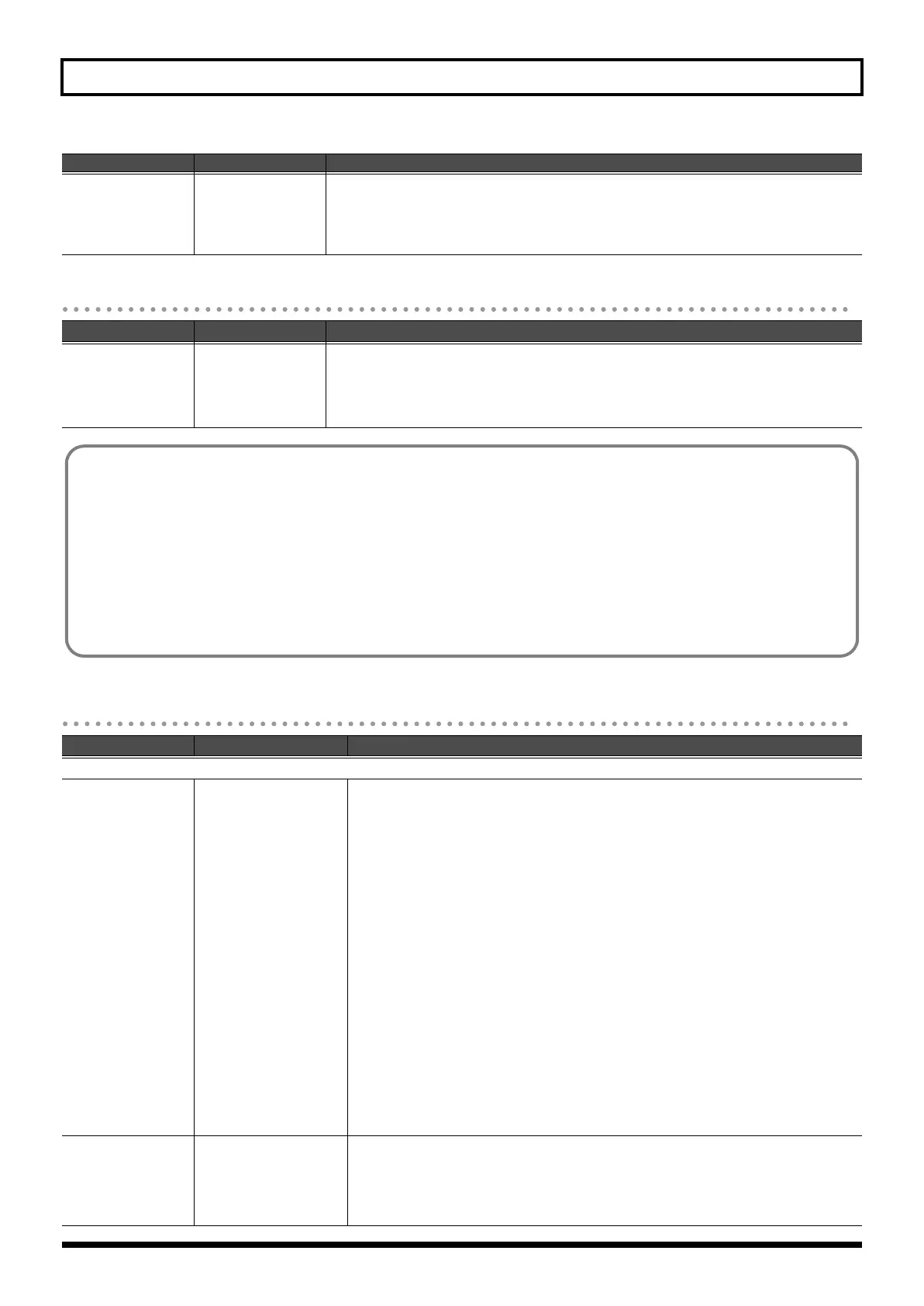148
Chapter 11. Other Settings
[4 (CTRL)]
[5 (SWITCH)]
Patch Select Polarity
STANDARD,
REVERSE
Selects the polarity of the pedal connected to the PATCH SELECT jack.
On some pedals, the electrical signal output by the pedal when it is pressed or released is the
opposite of other pedals. If your pedal has an effect opposite of what you expect, set this
parameter to “REVERSE.” If you are using a Roland pedal (that has no polarity switch), set this
parameter to “STANDARD.”
Parameter
Value Explanation
Sys Ctrl 1–4 Source
OFF, CC01–95,
PITCH BEND,
AFTERTOUCH
Selects the MIDI message used as the System Control.
OFF:
The system control knob will not be used.
CC01–95:
Controller numbers 1–95
PITCH BEND:
Pitch Bend
AFTERTOUCH:
Aftertouch
Parameter
Value Explanation
ASSIGNABLE Switch
Assign
FAVORITE UP,
FAVORITE DOWN,
PROGRAM UP,
PROGRAM DOWN,
TRANSPOSE UP,
TRANSPOSE DOWN,
TAP TEMPO,
MONO/POLY,
PORTAMENTO,
HOLD,
MFX1–3 SW,
CHORUS SW,
REVERB SW,
SYS CTRL 1–4 SRC,
BEND MODE,
START/STOP
The function assigned to [FAVORITE UP/ASSIGNABLE]
FAVORITE UP:
Select the favorite of the next number or bank.
FAVORITE DOWN:
Select the favorite of the preceding number or bank.
PROGRAM UP:
Select the next-numbered patch in Patch mode, or the next-numbered
performance in Performance mode.
PROGRAM DOWN:
Select the previous-numbered patch in Patch mode, or the
previous-numbered performance in Performance mode.
TRANSPOSE UP:
Raise the key range in semitone steps (maximum of 6 semitones).
TRANSPOSE DOWN:
Lower the key range in semitone steps (maximum of 5 semitones).
TAP TEMPO:
Tap tempo (set the tempo by pressing the button at the desired interval).
MONO/POLY:
Switch the patch between polyphonic (POLY) or monophonic (MONO)
playing.
PORTAMENTO:
Turn portamento on/off.
HOLD:
Turn hold on/off.
MFX1–3 SW:
Multi-effect 1–3 switch.
CHORUS SW:
Chorus switch.
REVERB SW:
Reverb switch.
SYS CTRL 1–4 SRC:
Transmit the MIDI message specified by “Sys Ctrl 1–4 Source.”
BEND MODE:
Switch the bend mode (p. 146).
“NORMAL” when the button is off, “CATCH+LAST” when the button is on.
START/STOP:
Start/stop the song or rhythm pattern.
Type
LATCH, MOMENTARY
The way in which [FAVORITE UP/ASSIGNABLE] will operate when pressed.
LATCH:
The on/off status will alternate each time you press the button.
MOMENTARY:
The function is turned on while you press the button, and is turned off when
you release it.
* Depending on the Assign setting, this may not be available.
Parameter
Value Explanation
System Control
This function, which departs from previously used methods, and instead allows you to use MIDI messages to change tone settings in realtime, is
called the
Matrix Control (p. 110). Similarly, the function allowing you to use MIDI messages to change multi-effects settings in realtime is called
the Multi-effects Control (p. 84).
Normally, the Matrix Control is used for making patch settings, and the Multi-effects Control for making settings to patches, rhythm sets, and
performances.
For example, if you want the same MIDI message to always be used for matrix control for other patches as well, select that MIDI message as Sys
Ctrl 1 Source, and select “SYS CTRL 1” as the CTRL Source for the other patches. With these settings, even if you need to change the MIDI
message used for matrix control, all you need to do is simply choose a different MIDI message as the Sys Ctrl 1 Source. In other words, you
could call the System Controls global Matrix Control/Multi-effects Control for the entire JUNO-STAGE.
You can use up to four System Controls.
JUNO-STAGE_e.book 148 ページ 2008年10月17日 金曜日 午後12時27分

